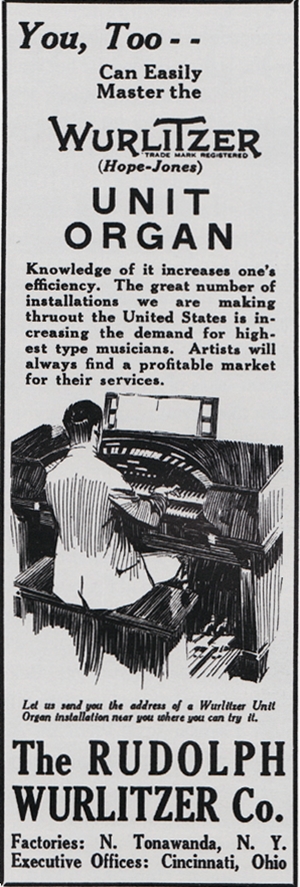Theatre Organ History - The Builders
Theatre Organ History - The Builders
 In the teens and twenties, several thousand theatre pipe organs were installed across America. Many also made their way to Europe and beyond. They were particularly popular in England and her colonies, and several English firms built them for the domestic market.
In the teens and twenties, several thousand theatre pipe organs were installed across America. Many also made their way to Europe and beyond. They were particularly popular in England and her colonies, and several English firms built them for the domestic market.
The term "theatre organ" originally referred to any organ installed in a theatre, but as the instrument evolved, the term began to refer to this specific type of instrument, whether or not it was installed in a theatre. Thus, theatre organs were also installed and used in sports arenas, civic auditoria, and even churches!
Unfortunately, after some major disagreements with the Wurlitzer management, Robert Hope-Jones took his own life in 1914 -- but not before profoundly influencing the development of the theatre organ. The Wurlitzer company continued to flourish, however, becoming the largest manufacturer of theatre pipe organs in the world. Indeed, while there were many other builders of these instruments, the name "Wurlitzer" became generically synonymous with the theatre organ, in the same way that Kleenex and Frigidaire were to later become generic terms.
Other important builders of theatre organs
- Bartola Musical Instrument Company (maker of the Barton organ) of Oshkosh, Wisconsin
- Robert Morton Company of Van Nuys, California
- Marr & Colton Company of Warsaw, New York
- Page Organ Company of Lima, Ohio
Virtually every builder of church and concert pipe organs also built at least a few theatre organs during the 'teens and twenties. Companies that produced significant quantities of theatre organs or who contributed in important ways to the development of the instrument included:
- M. P. Moller, Inc., of Hagerstown, Maryland
- Wicks Organ Company of Highland, Illinois
- George Kilgen & Sons, Inc., of St. Louis, Missouri
- W. W. Kimball Company of Chicago, Illinois
In England, the Compton and Christie firms became well-respected manufacturers of theatre organs.
